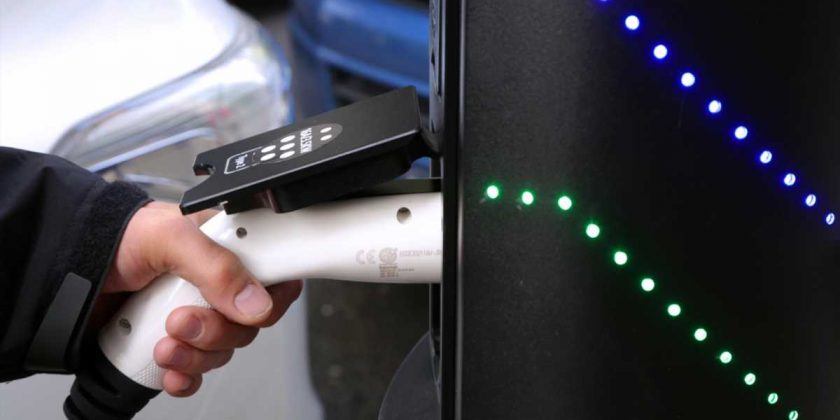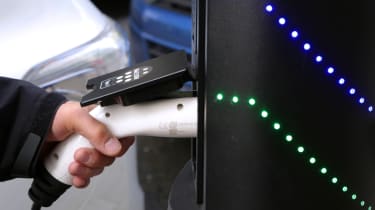International Council on Clean Transportation warns target of 50 to 70% of new cars being EV or PHEV by 2030 will require at least 341,000 public and workplace chargers
The UK’s drive towards an electrified vehicle fleet will require a vast expansion of public and workplace chargepoints, according to fresh research.
The International Council on Clean Transportation says that while it recognises home charging accounts for roughly 60 per cent of all charging, the UK’s network of 22,613 public and workplace chargers will need to vastly increase, to between 341,000 to 430,000 points by 2030.
Best electric cars to buy 2020
This will be necessary to meet the demand predicted to be brought about by the 5.2 to 6.7 million EVs that will be on the road by then, when 50 to 70 per cent of the new-car marker is expected to be made up of ultra-low emission vehicles (which emit under 50g/km of CO2 and can travel at least 70 miles on a single charge).
To meet this demand, the ICCT says a vast expansion is required, with 30 per cent more public chargepoints needed every year. The organisation also highlights that these chargepoints should be fast chargers in order to facilitate quick changeover between charging sessions.
While the ICCT says London and Scotland have relatively high proportions of chargepoints, with around 25 per cent of the chargers expected to be required by 2030, large sections of the UK, including parts of the Midlands, south Wales and Northern Ireland have fewer than 10 per cent.
The UK Government initially planned to outlaw sales of new cars with an internal combustion engine by 2040, but that date now looks set to be 2035, if not sooner.
As well as increasing the number of public chargepoints available, however, the reliability of the network will have to be improved as well if drivers aren’t to experience frustration when charging on the move. Given some of the results in our inaugural Driver Power chargepoint survey, it seems significant improvements are required by some firms.
Government to double number of electric car rapid public chargepoints
A £70-million Government fund will see the number of public rapid electric car chargepoints in the UK more than double over the next five years, with 3,000 new units installed across the country by 2024.
The funding comes as part of a wider £400-million package that aims to “bolster” Britain’s EV infrastructure, and will see the UK’s public chargepoint network number 5,000 individual chargers.
A Government review of chargepoint provision across major road networks is also underway, with ministers keen to determine where points can be best-placed for motorists.
Getting the UK’s public charging infrastructure right is seen as fundamental to the Government’s plan to ban all conventional new petrol and diesel cars from sale by 2040, in order to meet clean-air and environmental targets. But parts of Great Britain – including many areas of Wales – are home to EV charging deserts and this, coupled with a lack of off-street parking in the towns and cities where 83 per cent of the population lives, means charging EVs remains problematic for many motorists, no matter how attractive Government subsidies and other ownership benefits make EVs.
While no specific details of charger speeds have been revealed by the Department for Transport (DfT), rapid chargepoints are typically capable of delivering electricity at a minimum of 50kW, meaning a typical ‘full’ charge, which would replenish an electric car’s battery from 20 to 80 per cent, takes roughly 40 minutes. The DfT highlights, however, that the latest-generation of chargers can replenish an EV’s batteries in as little as 20 minutes.
Models like the recently announced Volkswagen ID.3, for example, can be optioned with the capability of accepting a charge at 100kW, while the Porsche Taycan capable of accepting a 270kW charge – although no public chargers are currently able to deliver that rate. The Tesla Model 3, meanwhile, which was the third-best-selling car in the UK in August as long-awaited deliveries took place, can accept a charge at up to 200kW.
Reliability will be key to this latest round of 3,000 new rapid chargers. Ecotricity, which has contracual links with much of the UK’s motorway services network, has faced stiff criticism in social and other media outlets for the reported unreliability of its chargers, with the company recently announcing a price increase to allow it to upgrade its network.
Government invests £40m to overcome on-street electric-car charging hurdles
This latest investment follows an announcement back in July from the Department for Transport that it would invest £37m in a series of 12 projects that aim to tackle the issue of where drivers who park on the street can charge their electric cars. Wireless charging pads that remove the need for trailing wires, EV chargers that pop up out of the pavement, and a project that will see multiple chargepoints installed in car parks for the “mass charging” of EVs at night are among the schemes to receive funding.
EV charging company Char.gy, which last year installed London’s first lamp post chargers, has been awarded over £2.3 million to develop and deploy wireless chargers on residential streets, while consultants Urban Foresight have won over £3m to roll out a series of pop-up chargers that emerge from the kerb. Virgin Media is also involved in the project, and will see its infrastructure leveraged so that charging information and behaviour can be made best use of.
• UK charging network: everything you need to know
The DfT is also investigating chargepoints that can deliver “semi-rapid” charging using without the need for expensive upgrades of electricity substations. “Solar forecourts”, which use capture the sun’s energy to charge groups of EVs, will also receive central investment.
Between 25 and 45 per cent of UK residents have no access to off-street parking, equivalent to at least nine million cars. Chargepoint companies will typically not install a home wallbox in properties without a garage or driveway, while households without off-street parking are ineligible for home-charger grants.
Yet the Government plans to ban the sale of all new cars that do not feature some form of electrification by 2040. While full details of this ban are still forthcoming, reports indicate new cars must be capable of covering at least 50 miles in battery-only mode in order to be judged “effectively” zero emission, and remain on sale after this date. Those cars,– essentially plug-in hybrids and EVs – will have to be charged up to make the best use of their eco-driving credentials and help the UK meet its official target of being carbon-neutral by 2050.
Air quality in urban areas is another reason for the move towards EVs, but the scarcity of driveways and garages in the UK’s towns and cities, and London in particular, is perceived as a barrier to EV ownership by many. Previous urban projects have seen street lights adapted to offer EV chargers, but charging rates from these tend to be low, while councils prefer to site new lamp posts away from the kerb to improve access for pavement users, resulting in trailing wires on the street.
All the projects being targeted by the funding have passed three-month feasibility studies, and have emerged as part of the Government’s Future of Mobility Grand Challenge, which seeks to make transport cleaner, easier and safer.
Commenting on the investment, Jack Cousens, the AA’s head of roads policy, said wireless charging “may prove to be the solution for residential streets”, but warned, “more needs to be done in the short-term to convince drivers to replace their petrol or diesel vehicle to an electric car.”
Check-out our verdict on the best electric vans on sale today…
Source: Read Full Article



 Best electric cars to buy 2020
Best electric cars to buy 2020